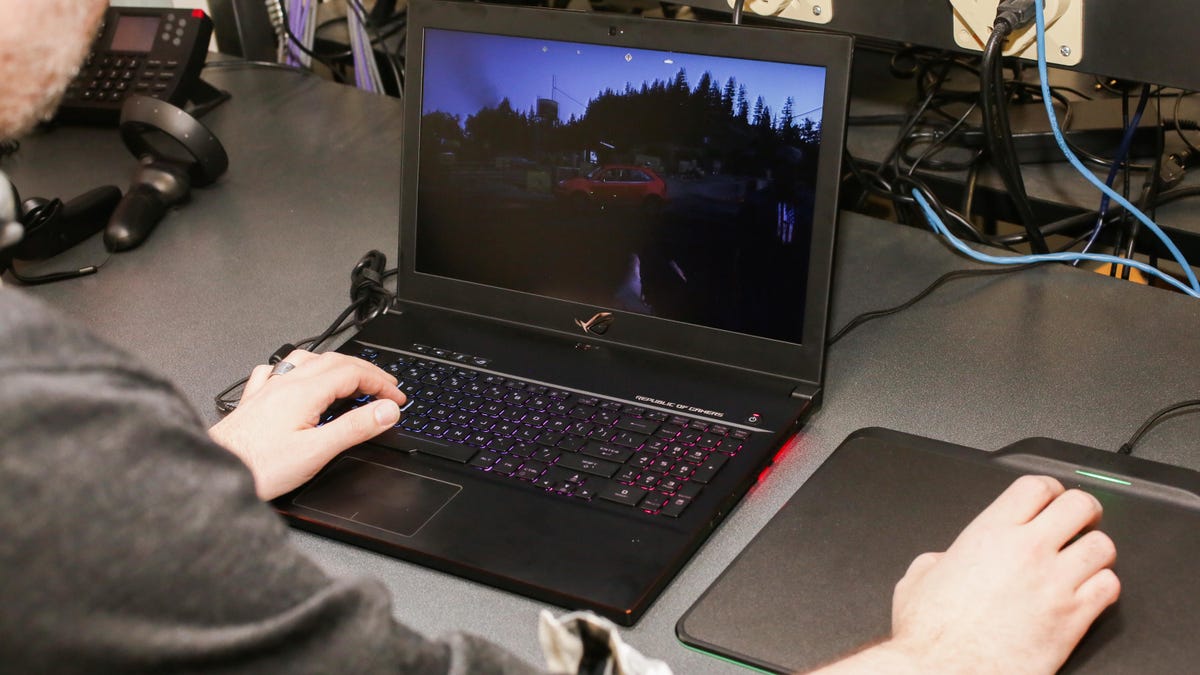
Asus ROG Zephyrus M GM501
Asus was one of the first manufacturers to use Max-Q architecture for a slim gaming design, and now it's one of the first to use the six-core i7. I had a chance to test this one out and it delivered noticeably better performance. I was pleased to see that Asus fixed several of the issues we had with the design, notably the oddly placed touchpad.
If you're not sure what all the fuss is about the new wave of Intel mobile CPUs, get ready for six-core performance in mainstream gaming and graphics-pro laptops.
Samsung Odyssey Z
The Odyssey Z is Samsung's attempt to recover from the design bashing of its gaming laptops in previous years. We don't know a lot about it, though it's a good bet the company wants you to use it with its Odyssey VR headset. But it looks cool (or at least different), so here are some photos of it.
Samsung Odyssey Z
I will say, that touchpad is in a spot we've hated on other gaming systems.
Samsung Odyssey Z
Shiny! Not a typical look for a gaming system.
Samsung Odyssey Z
No boring iconography here!
Samsung Odyssey Z
Its profile is out of the ordinary as well.
MSI GT series
MSI's kitchen-sink gaming laptops can be configured with top-of-the-line everything, including an overclockable i9. Plus, it has a rarity among gaming laptops, individually configurable RGB LED backlighting for the keyboard. It'll set you back, though: the six-core i7 models start at $2,200 and a Core i9 GT75 will cost you upwards of $3,000.
MSI GS65 Stealth
The company's ultraslim model maxes out at a hexacore i7 to keep its svelte shape, but it's also one of the first laptops to incorporate an HD 144Hz wide-viewing-angle panel and per-key RGB backlighting. And for all that with a GTX 1060, it starts at a pretty reasonable $1,800.
Asus ROG G702
It was packed with high-end components when it launched, such as an overclockable 7th-gen Core i7, so we shouldn't be surprised that the update now goes up to i9.
Alienware 17 R5
Now you can pair your overclocked GTX 1080 with a factory-overclocked-to-5GHz i9-8950HK. For much $$.
Alienware 15 R4
The big deal for this littler laptop is that now the 15-inch model supports overclocking -- and with an i9, to boot. The line also gets non-G-Sync versions of the display, if you need to save a few pennies.
Dell G3 15
Dell's new non-gamer-gaming line, formerly known as the Inspiron 15, is now dubbed the G series. The G3 has a fairly slim design. It's not Max-Q thin, but pretty good for a gaming laptop. And it incorporates the latest i7s, though it tops out at the quad cores. Not bad for a laptop that starts at $750.
Dell G3 17
Dell's G3 series adds a big 17-inch model, but no hexacore versions of the 8th generation CPUs. They're strictly quad-core for your starting price of $800.
Dell G5 15 and G7 15
Like the G3, the G5's for the budget gamer; it starts at $800 and you can configure it with up to a six-core i7. But the G7 will go up to an i9, which is pretty amazing for a budget line. You're still limited to a maximum of the GTX 1060, though.
Dell XPS 15
One of our favorite mainstream laptops is also getting a boost. It's had discrete Nvidia graphics for a while, and now you can configure it with up to a GTX 1050 Ti and a Core i9, making it even more perfect for your graphics work and play.
Origin PC Evo15-S
Origin PC's Max-Q laptop doesn't look any different. But the slim and lightish Evo15-S and its pro-graphics focused NT-15 doppelganger now jump to hexacore from quad. LIke the MSI GS65, it also gets an option for a 144Hz HD display.
Acer Aspire Nitro 5
It hasn't changed a bit, but Acer's Nitro 5 budget gaming line moves to 8th-gen i5 (quad core) processors starting at $750. There will i7 models as well, but Acer hasn't shared the details yet.


